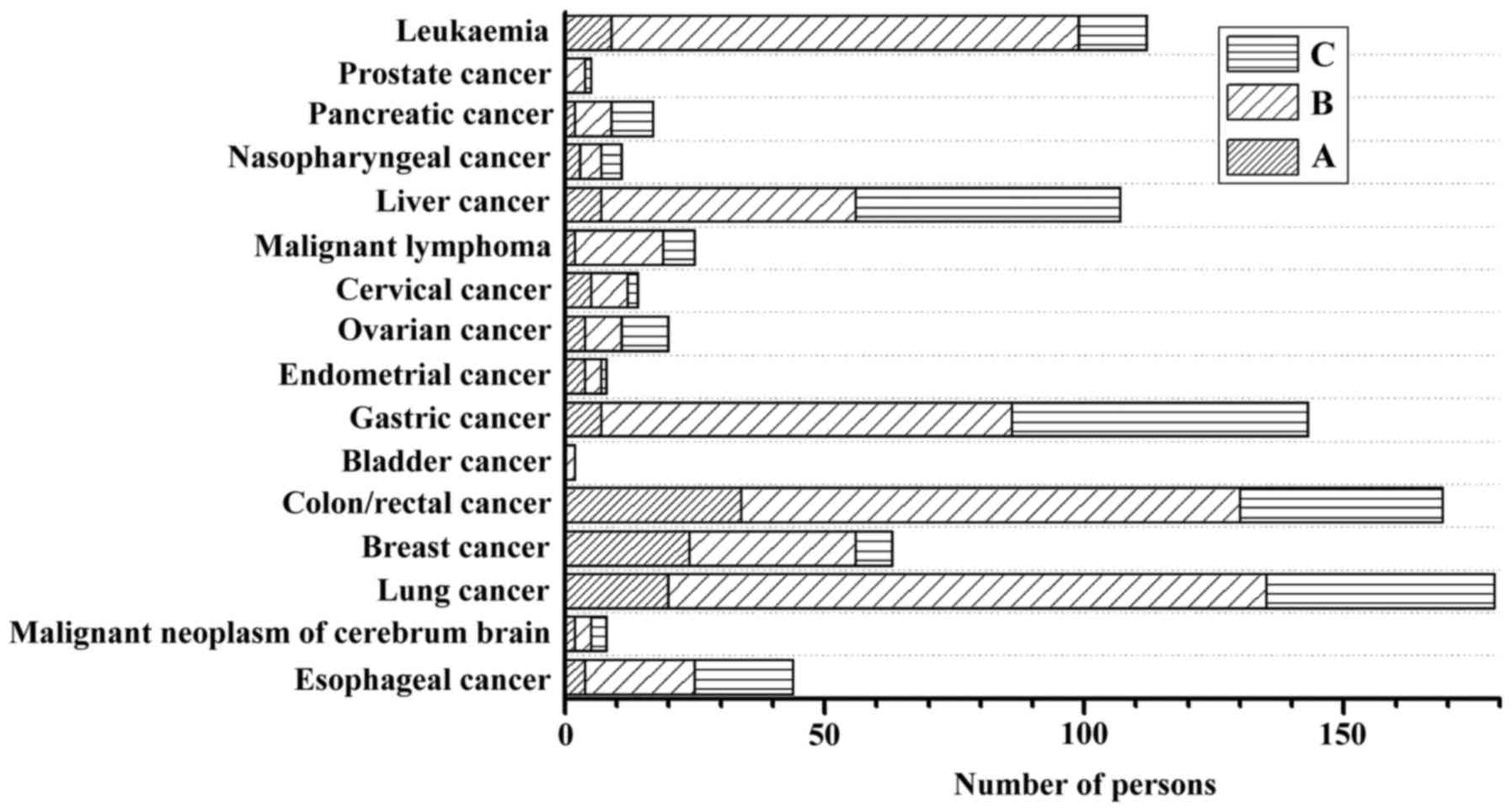|
1
|
Moore MA, Ariyaratne Y, Badar F, Bhurgri
Y, Datta K, Mathew A, Gangadharan P, Nandakumar A, Pradhananga KK,
Talukder MH, et al: Cancer epidemiology in South Asia - past,
present and future. Asian Pac J Cancer Prev. 11 Suppl 2:49–66.
2010.PubMed/NCBI
|
|
2
|
Thoresen L, Fjeldstad I, Krogstad K, Kaasa
S and Falkmer UG: Nutritional status of patients with advanced
cancer: The value of using the subjective global assessment of
nutritional status as a screening tool. Palliat Med. 16:33–42.
2002. View Article : Google Scholar : PubMed/NCBI
|
|
3
|
von Meyenfeldt M: Cancer-associated
malnutrition: An introduction. Eur J Oncol Nurs. 9 Suppl 2:S35–S38.
2005. View Article : Google Scholar : PubMed/NCBI
|
|
4
|
Shaw C, Fleuret C, Pickard JM, Mohammed K,
Black G and Wedlake L: Comparison of a novel, simple nutrition
screening tool for adult oncology inpatients and the Malnutrition
Screening Tool (MST) against the Patient-Generated Subjective
Global Assessment (PG-SGA). Support Care Cancer. 23:47–54. 2015.
View Article : Google Scholar : PubMed/NCBI
|
|
5
|
Kondrup J, Allison SP, Elia M, Vellas B
and Plauth M: Educational and Clinical Practice Committee, European
Society of Parenteral and Enteral Nutrition (ESPEN): ESPEN
guidelines for nutrition screening 2002. Clin Nutr. 22:415–421.
2003. View Article : Google Scholar : PubMed/NCBI
|
|
6
|
Ottery FD: Definition of standardized
nutritional assessment and interventional pathways in oncology.
Nutrition. 12 Suppl:S15–S19. 1996. View Article : Google Scholar : PubMed/NCBI
|
|
7
|
Ottery FD: Rethinking nutritional support
of the cancer patient: The new field of nutritional oncology. Semin
Oncol. 21:770–778. 1994.PubMed/NCBI
|
|
8
|
Bauer J, Capra S and Ferguson M: Use of
the scored Patient-Generated Subjective Global Assessment (PG-SGA)
as a nutrition assessment tool in patients with cancer. Eur J Clin
Nutr. 56:779–785. 2002. View Article : Google Scholar : PubMed/NCBI
|
|
9
|
Gabrielson DK, Scaffidi D, Leung E,
Stoyanoff L, Robinson J, Nisenbaum R, Brezden-Masley C and Darling
PB: Use of an abridged scored Patient-Generated Subjective Global
Assessment (abPG-SGA) as a nutritional screening tool for cancer
patients in an outpatient setting. Nutr Cancer. 65:234–239. 2013.
View Article : Google Scholar : PubMed/NCBI
|
|
10
|
Ottery FD: Patient-Generated Subjective
Global AssessmentThe Clinical Guide to Oncology Nutrition. McCallum
PD and Polisena CG: American Dietetic Association; Chicago, IL: pp.
11–23. 2000
|
|
11
|
Heymsfield SB, Baumgartner RN and Pan SF:
Nutritional assessment of malnutrition by anthropometric
methodsSHILS, ME Modern Nutrition in Health and Disease. Williams
and Wilkins; Baltimore, MD: 1999
|
|
12
|
Thomas B: Manual of dietetic practice.
2nd. Oxford: Blackwell; pp. 52–57. 1994
|
|
13
|
Silva FR, De Oliveira MG, Souza AS,
Figueroa JN and Santos CS: Factors associated with malnutrition in
hospitalized cancer patients: a croos-sectional study. Nutr J.
14:1232015. View Article : Google Scholar : PubMed/NCBI
|
|
14
|
Fukuda Y, Yamamoto K, Hirao M, Nishikawa
K, Maeda S, Haraguchi N, Miyake M, Hama N, Miyamoto A, Ikeda M, et
al: Prevalence of malnutrition among gastric cancer patients
undergoing gastrectomy and optimal preoperative nutritional support
for preventing surgical site infections. Ann Surg Oncol. 22 Suppl
3:S778–S785. 2015. View Article : Google Scholar : PubMed/NCBI
|
|
15
|
Wie GA, Cho YA, Kim SY, Kim SM, Bae JM and
Joung H: Prevalence and risk factors of malnutrition among cancer
patients according to tumor location and stage in the National
Cancer Center in Korea. Nutrition. 26:263–268. 2010. View Article : Google Scholar : PubMed/NCBI
|
|
16
|
Isenring E, Bauer J and Capra S: The
scored Patient-generated Subjective Global Assessment (PG-SGA) and
its association with quality of life in ambulatory patients
receiving radiotherapy. Eur J Clin Nutr. 57:305–309. 2003.
View Article : Google Scholar : PubMed/NCBI
|
|
17
|
Bozzetti F; SCRINIO Working Group, :
Screening the nutritional status in oncology: A preliminary report
on 1,000 outpatients. Support Care Cancer. 17:279–284. 2009.
View Article : Google Scholar : PubMed/NCBI
|
|
18
|
Bauer J and Capra S: Comparison of a
malnutrition screening tool with subjective global assessment in
hospitalised patients with cancer - sensitivity and specificity.
Asia Pac J Clin Nutr. 12:257–260. 2003.PubMed/NCBI
|
|
19
|
Orell-Kotikangas H, Österlund P,
Saarilahti K, Ravasco P, Schwab U and Mäkitie AA: NRS-2002 for
pre-treatment nutritional risk screening and nutritional status
assessment in head and neck cancer patients. Support Care Cancer.
23:1495–1502. 2015. View Article : Google Scholar : PubMed/NCBI
|
|
20
|
Souza Thompson, Motta R, Castanho I Alves
and Velarde L Guillermo Coca: Cutoff point of the phase angle in
pre-radiotherapy cancer patients. Nutr Hosp. 32:2253–2260.
2015.PubMed/NCBI
|
|
21
|
Chen W, Zheng R, Zeng H and Zhang S: The
updated incidences and mortalities of major cancers in China, 2011.
Chin J Cancer. 34:502–507. 2015. View Article : Google Scholar : PubMed/NCBI
|















